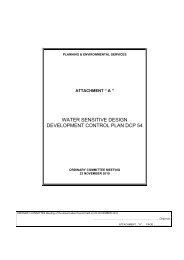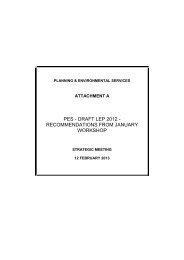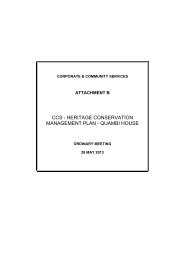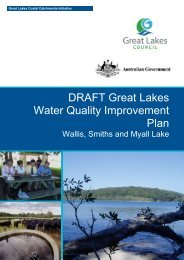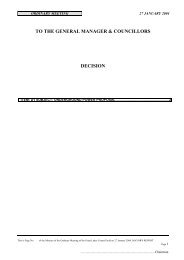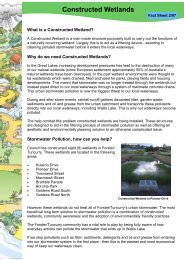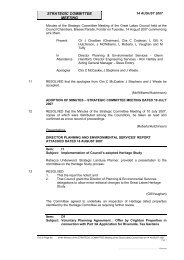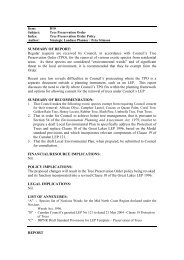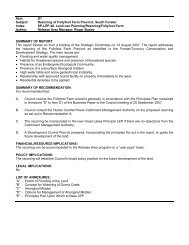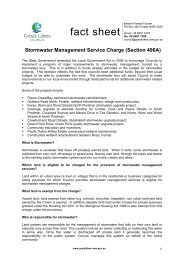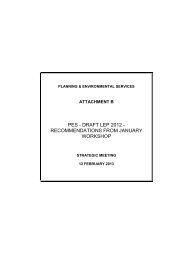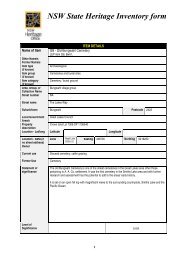smiths lake planning study volume 1: text - Great Lakes Council
smiths lake planning study volume 1: text - Great Lakes Council
smiths lake planning study volume 1: text - Great Lakes Council
Create successful ePaper yourself
Turn your PDF publications into a flip-book with our unique Google optimized e-Paper software.
SOILS AND GEOTECHNICAL 22<br />
2.6 Urban Capability And Development Guidelines - SLVA<br />
2.6.1 Foundation Conditions<br />
Subsurface conditions in the SLVA generally comprise clay soils overlying rock at a relatively<br />
shallow depth, typically 0.5m to 1m with some areas of surface rock outcrop. The clay soils<br />
and weathered rock materials noted in the SLVA are generally considered to be of adequate<br />
bearing capacity for residential development.<br />
Specific geotechnical assessment of soil bearing capacity should be undertaken in sand soil<br />
areas of the SLVA (terrain units S1, S2, S3 and S4).<br />
Excavation problems are likely to be encountered where rock is encountered in earthworks.<br />
Testing of rock core recovered by the Department of Public Works for the sewer reticulation<br />
indicates that the rock is of high to very high strength with tested unconfined compressive<br />
strengths in the range of 50 to 150 MPa. The orientation and spacing of rock joints and<br />
fractures will have a major influence on rock excavatability.<br />
Based on the results of linear shrinkage testing and the highly plastic nature as presented in<br />
Table 2-4, the clay soils present in the SLVA are likely to be reactive (expansive). Reactive<br />
clays are soils that swell on wetting and shrink on drying, resulting in ground movements that<br />
can damage lightly loaded structures founded on inappropriately designed footing systems. The<br />
amount of ground movement is mainly related to the physical properties and depth of the clay<br />
and environmental factors such as climate, vegetation and watering. A higher probability of<br />
damage can occur on reactive sites where abnormal moisture conditions occur, due to factors<br />
such as:<br />
• Growth of trees too close to a footing or removal of large trees prior to construction.<br />
• Lack of maintenance of site drainage, failure to repair plumbing leaks and excessive or<br />
irregular watering of gardens adjacent to the house.<br />
• Unusual moisture conditions caused by removal of structures, ground covers (pavements),<br />
drains and dams etc.<br />
Foundation design should be undertaken in accordance with AS2870 – 1996 Residential Slabs<br />
and Footings. AS2870 – 1996 establishes performance requirements and specific designs for<br />
common foundation conditions as well as providing guidance on the design of footing systems<br />
using engineering principles.<br />
2.6.2 Slope Stability<br />
Slope stability zonation for the SLVA is shown on Figure 2-2 with zones defined on the basis<br />
of risk of instability as defined in Table 2-14. Four zones have been defined:<br />
• High Risk - steep (>25-40%) sand covered slopes (ie. in the area of Amaroo Drive and<br />
along the foreshore below Ski Cove Street. Terrain units S3 and S4.<br />
• High Risk - steep (>40%) soil and rock slopes located along some foreshore areas of Symes<br />
Bay. Terrain unit R1.<br />
SMITHS_LAKE_PLANNING_STUDY.DOC<br />
O C E A N I C S<br />
A U S T R A L I A




